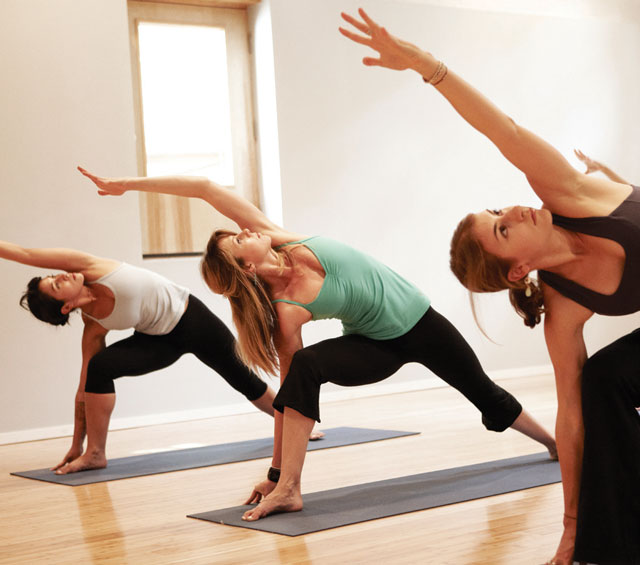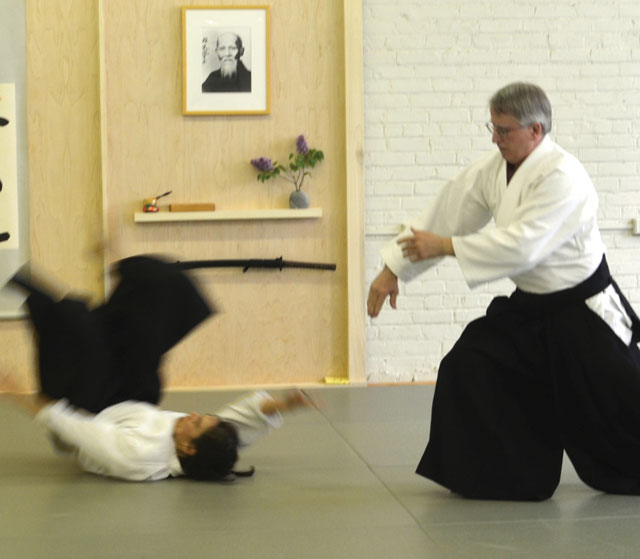It’s not your fault. The skies are gray and it’s too cold to leave your bed for any reason except to pee and to make more tea. Winter is a threat to mental stability, and gorging on eggnog and leftovers is one of the few ways to persevere. Unfortunately, all that deliciousness also means the dreaded holiday fifteen, or twenty, or thirty, if things really get out of hand. But it doesn’t have to be that way!
Whether you have an established fitness routine or an unused gym membership, now is the perfect time to try something new. I’m not saying put down the hot cocoa, but working out can be another way to ward off seasonal affective disorder. And it doesn’t have to be twenty minutes on the treadmill followed by fifty crunches and ten reps of whatever. Here is where we call in the experts. Janine Flasschoen owns The Fifth Line, which offers your yoga and Pilates classes, but also teaches the Gyrotonic method. Gyrotonic may seem at first to be the new Pilates with a super-official name. But it’s more than a fitness fad—it’s a way of life and a defense mechanism extraordinaire against the winter blues.
And what is this newfangled Gyrotonic you ask? Flasschoen explains it best: “Similar to dance, it uses the entire body in continuous movement, building elongated muscular strength while increasing flexibility and range of motion. The coordination component keeps the mind actively working and refining the neuromuscular pathways. Like yoga, it emphasizes various breathing techniques that center the mind, calm the nervous system, or, when coordinated with movement, efficiently propel the body. Movements can be done with speed, stimulating the cardiovascular system, or it can be done slowly and more meditatively, nourishing the body and mind.”
So basically it’s all the best elements of a workout combined into one. Flasschoen’s mentality about working out pretty much sums up the energy of the Gyrotonic method and the point of this article: “Fitness is not only about toning, conditioning and fitting into those skinny jeans, but about physical, mental, emotional and spiritual well-being.”
 Of course, I would be remiss not to mention yoga when talking about physical and mental well-being. Yoga is one those fitness trends we’ve probably all tried a few times before losing our yoga mats in the depths of our closets. But perhaps we haven’t been seeing beyond the hippie-dippy mumbo jumbo of it all.
Of course, I would be remiss not to mention yoga when talking about physical and mental well-being. Yoga is one those fitness trends we’ve probably all tried a few times before losing our yoga mats in the depths of our closets. But perhaps we haven’t been seeing beyond the hippie-dippy mumbo jumbo of it all.
The point of yoga isn’t to immediately escape our tendencies toward hibernation or “turning inward,” as the founder of Yogasana, Kristen Davis, calls it. Rather, it’s a way to give in to those tendencies while simultaneously breaking free from them. According to Davis, “We see our habits; we see the imprint of our thinking, our way of being, on the body. It’s far more profound than just stretching and strengthening (although it is that too). It changes us.” It’s like therapy: you have to want to get better for it to work. Davis’ description of her first experience with yoga exemplifies her open-mindedness towards the exercise: “The first yoga class I took left me feeling like some strange cubist painting, like I’d been taken apart and put back together again. I fell in love with it!” I think we’d all benefit from temporarily being a cubist painting, and the instructors at Yogasana will help you do just that. They tend to the needs of each individual student, so it’s almost like seeing a shrink. Except instead of probing your mind, they probe your mind-body-soul.
T’ai chi is another one of those buzzwords you’ve heard floating around the New Age fitness atmosphere, and it’s also a recent addition to Park Slope. T’aichiinparkslope, currently hosted at the Annex at Ellie Herman’s Pilates Studio, opened just three months ago. T’ai chi is an age-old martial art that uses slow but precise movements to strengthen and relax the muscles. At first glance, it may appear to not be much of a workout. But you’ll actually be getting the chi flowing, and you won’t have to walk the streets sweaty and red-faced afterward.
Susan Hamovitch, the founder and director of T’aichiinparkslope, acknowledges your skepticism. “It may sound hocus pocus. What is chi, after all? The truth is, it’s an invisible ‘force;’ it can’t be seen or traced. But it has been shown over and over to not only exist, but to follow the meridians that have been identified in ancient Chinese medicine. Think acupuncture. Think remedies for arthritis, coughs, back pain, muscle aches—and far more deep-seated emotional and psychological stresses.”
Did that strike a chord with your inner hypochondriac? Because those dedicated to the practice of t’ai chi claim to rarely succumb to the common cold, and recent studies have shown the effectiveness of t’ai chi in helping with chronic pain in those with serious illnesses, as well as those of us suffering from the general ills of everyday life. According to Hamovitch, “The head of neurology at Methodist recommends patients with Parkinson’s get themselves into a t’ai chi program pronto.”
Jikishininkan Aikido Dojo is a non-profit organization dedicated to teaching aikido, another martial art form, but one that focuses on the art of defense. Jikishininkan translates to “direct mind” and reflects the Buddhist teachings the dojo promotes in its practice of aikido as well as zen meditation.
 One normally doesn’t associate zen with defending oneself against an attacker, an attacker who may very well have a knife or Samurai sword, for that matter. But Sensei Stewart Johnson, head instructor and dojo cho, explains, “The goal is to develop the necessary skill, focus, awareness and compassion to control an attack without injury to your attacker or yourself. Aikido is purely defensive in nature, relying on throws, joint locks and pins rather than disabling strikes. We strive to blend with the energy of the attack, redirecting and guiding it to a throw, joint lock or pin.”
One normally doesn’t associate zen with defending oneself against an attacker, an attacker who may very well have a knife or Samurai sword, for that matter. But Sensei Stewart Johnson, head instructor and dojo cho, explains, “The goal is to develop the necessary skill, focus, awareness and compassion to control an attack without injury to your attacker or yourself. Aikido is purely defensive in nature, relying on throws, joint locks and pins rather than disabling strikes. We strive to blend with the energy of the attack, redirecting and guiding it to a throw, joint lock or pin.”
The experience of being on the receiving end of an aikido defense demonstrates the level of control over both mind and body that is possible to achieve through aikido. Johnson says, “As a beginner student I had an opportunity to attack my sensei, and I remember that my reaction can be summed up in one word: bewilderment. I felt like I had voluntarily turned my punch into a gentle ellipse that spiraled down to the mat. I never once felt sensei ‘do’ anything to me. I was convinced I had done it to myself for reasons I simply could not fathom.”
But maybe you’re more of an adrenaline junkie than a zenmaster. Maybe you’re not. Maybe you just want to make more friends? The Brooklyn Road Runners Club may be the answer to two of your New Years Resolutions this year: 1) get fit and 2) meet new people. According to Michael Balbos, communications director of Brooklyn Road Runners, two members met through the running group and ended up getting married. Balbos himself invited two members to his own wedding. Balbos says, “The best thing about Brooklyn Road Runners are the friendships you make.”
Steve Bonal, founder and president of the Brooklyn Road Runners Club, wanted to start a runner’s group that balanced the serious with the social aspects of running. The group trains for races, and the standard route is around Prospect Park roadway, about 3.35 miles, and while they try not to leave anyone behind, be prepared to at least jog the distance. Even if you’re doing more chatting than jogging.
Balbos says, “Running is a very communal activity with lots of discussions going on during a group run. Many of our runners get together socially or coordinate separate runs together if life interferes and they can’t make our standard group runs. We also have a yearly awards ceremony and holiday party, a pre-New York City Marathon get together, and other social activities.” So even if you don’t meet the love of your life, you’re bound to make some new friends, and all of you will be hot and fit and ready to meet babes. Sign me up.
What it all boils down to is finding the right fitness routine for you. One that is fun, feels good, and keeps you motivated enough to keep going back. Let’s all take one final note from the fitness guru Janine Flasschoen: “As we head into the stress of the holidays, the cold winter months ahead, and feel the tendencies to hibernate, I think it is important to let fitness be all encompassing. Listen closely to what your body needs on any given day and allow your exercise to be nurturing.”
